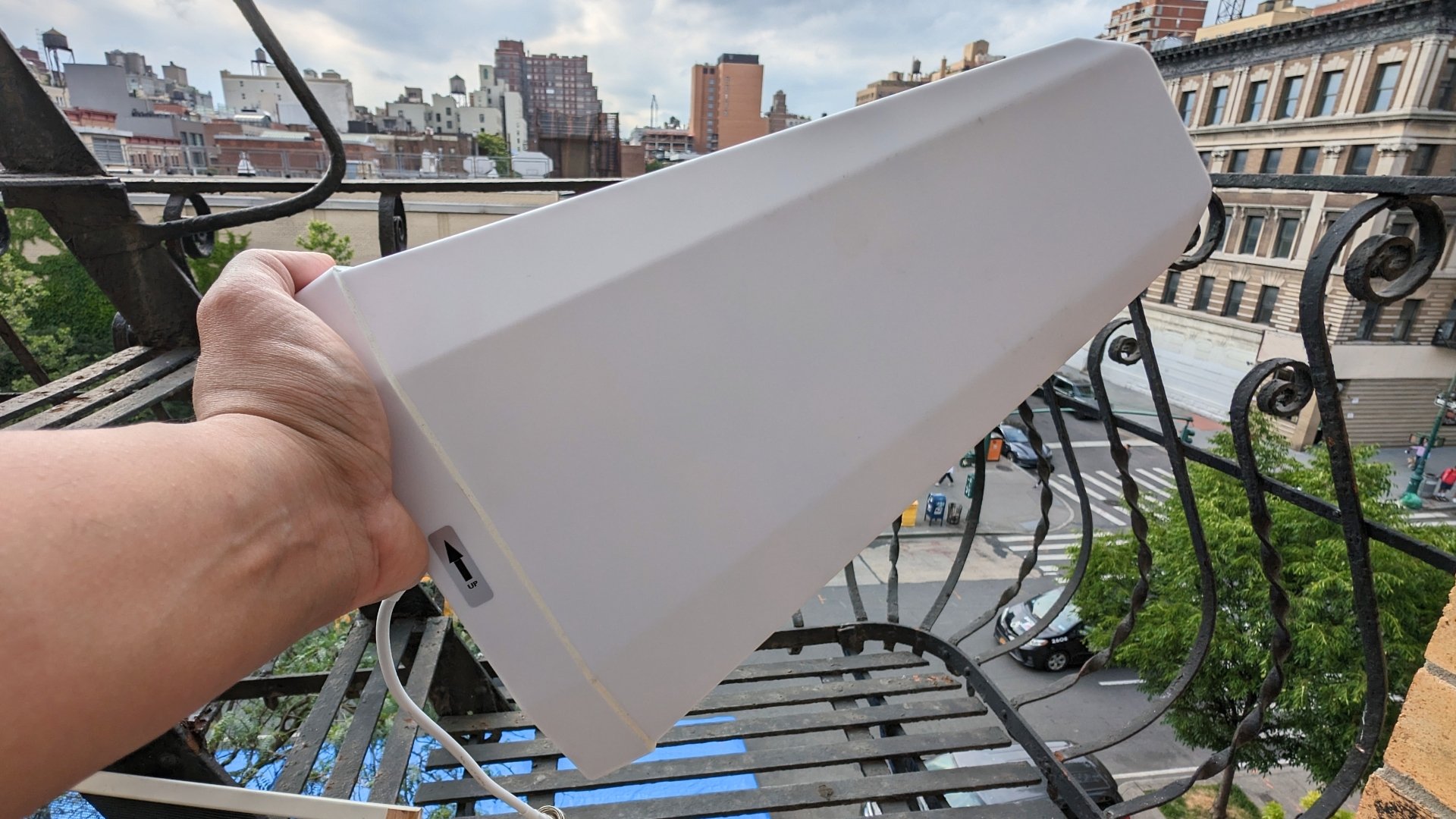-
Pros
- Improves 4G and 5G performance
- Works with multiple carriers
- Helpful LCD
- Includes mounting hardware
-
Cons
- Impractical setup distance recommendations for small spaces
Dealing with wireless carrier dead zones in your home can be a pain, but a signal booster like the $279.99 HiBoost Sidekick can help you stay connected. Designed for smaller homes, it amplifies the 4G and 5G signals of most major US carriers, leading to better call performance and faster data speeds. We like that it's easy to configure via comprehensive installation instructions and a companion app. The weBoost Home Studio ($349.99) is a little more compact and even easier to install, but it covers just two rooms. For spaces up to 2,000 square feet, we recommend the HiBoost Sidekick thanks to its consistent performance, helpful display, and lower price.
Design: Understated Style and Lots of Accessories
The HiBoost Sidekick comes with everything you need. The box includes the booster unit, an outdoor antenna, an indoor antenna, a power supply, three cables, a manual, and hardware for mounting the outdoor antenna to a wall or pole.
 (Credit: HiBoost)
(Credit: HiBoost)Thanks to its white and gray color scheme, the HiBoost Sidekick booster can likely blend into the background of your home. It measures 1.3 by 7.6 by 5.0 inches (HWD) and weighs 1.47 pounds. It includes two screw-on connectors, one each for the outdoor antenna cable and the indoor antenna, as well as a power port. A simple color LCD on the top surface provides details on the outdoor and indoor signal levels. You can access more detailed performance information from the free companion app (available for Android and iOS).
 (Credit: Iyaz Akhtar)
(Credit: Iyaz Akhtar)The outdoor antenna measures 8.2 by 11.1 by 2.0 inches and weighs 12.4 ounces. Although it's large, it's still light enough to set up easily.
Installation: Follow the Instructions
HiBoost includes a manual that clearly lays out the installation process. Make sure to read the documentation entirely before you start the setup since there is a specific order of steps. Notably, you must register the device with your mobile carrier and get its consent before you turn it on.
 (Credit: Iyaz Akhtar)
(Credit: Iyaz Akhtar)The HiBoost Sidekick can cover areas ranging from 500 to 2,000 square feet depending on your current signal strength. Cell signal boosters don't create new signals out of thin air—they amplify existing signals. If you get about two bars of service from your carrier, the Sidekick can use that to cover about 500 square feet in your home. Three or four bars of service will get you about 1,500 square feet of coverage inside, and five bars of service will cover a maximum of 2,000 square feet. For comparison, the weBoost Home Studio covers up to 1,500 square feet.
My two-bedroom apartment easily fits within the Sidekick's range, but the best one for your living space might differ. Larger homes call for more powerful boosters, for example, while RV owners must deal with the challenges of finding a signal at new locations everywhere they travel.
To get started with the Sidekick, first you must plug the power supply into the main unit without attaching any antenna cables. You can use either the LCD or the HiBoost Signal Supervisor app to complete the rest of the installation. I downloaded the app, paired the unit with my phone via Bluetooth, and entered my Wi-Fi network details to enable remote monitoring.
 (Credit: Iyaz Akhtar)
(Credit: Iyaz Akhtar)Next, I had to find a nearby cell tower to correctly position the outdoor antenna. The manual explains how to use your Android or iOS device to do this; essentially, I had to walk around my home with my phone until it detected the strongest signal. HiBoost suggests using the OpenSignal app (available for Android and iOS) or Network Cell Info Lite (available for Android only) to measure signal strength. I used a Samsung Galaxy Z Fold 5 to measure the signal by checking the SIM card status in Settings. HiBoost offers tech support should you run into any issues during this step.
In my case, finding the closest cell tower was relatively simple. For testing purposes, I simply placed the outdoor antenna on my fire escape and pointed it in the proper direction. HiBoost recommends securing the antenna to a wall or pole.

The cable from the outdoor antenna connects to a sturdy, thin "through-window cable" that can withstand the pressure of a closed window atop it. In other words, drilling a hole through your outer wall is optional. The final step is to attach the cable to the booster.
Once connected, I again used the companion app to fine-tune the outdoor antenna's position. The app shows four gauges with simplified, color-coded connection strength measurements (ranging between Poor and Super) to help. The readings don't update instantaneously, so make sure to pause and reassess between adjustments. If the system isn't functioning properly, the app and LCD will display Alarm as the status.

The indoor antenna easily screws into the booster unit. It has an omnidirectional pickup, so there's no need to calibrate it like the outdoor one. Placing the booster in a central area of your home helps ensure the best indoor coverage.
HiBoost has some spatial setup suggestions for the unit if you want optimal performance. For example, it says to place the booster unit 13 feet lower in elevation than the outdoor antenna and to put 30 lateral feet between the indoor and outdoor antennas. I couldn't reach the elevation requirement in my apartment, though I placed the indoor unit as far from the outdoor antenna as I could (around 12 feet).
Performance: Better Speeds Across the Board
The HiBoost Sidekick supports cellular bands 4, 5, 12/17, 13, and 25/2, all of which fall under the 4G LTE umbrella. Some carriers also transmit 5G in bands n25/2, n4 (a subset of n66), and n5 (a subset of n26) with the same frequencies as 4G LTE, so there is some overlapping coverage. None of these bands cover the fastest forms of 5G (C-band or mmWave). Instead, they only cover the frequencies the FCC allows for residential boosting. The device is compatible with all three major US carriers (and their MVNOs) and can boost multiple carriers simultaneously.
I tested the HiBoost Sidekick with an Apple iPhone 13 Pro on AT&T and a Google Pixel 8 Pro, Samsung Galaxy S24, and Samsung Galaxy Z Fold 5 on T-Mobile.
For the purposes of testing, I measured each phone's signal strength on 4G and 5G in four different locations in my apartment. Signal strength results are in decibels-milliwatts (dBm). Generally speaking, readings of -65dBm to -85dBM are excellent, -85dBm to -100dBm is good, and anything over -120dBm is poor. You can see the results for signal strength before and after installing the booster in the chart below.
Some general findings:
- The booster improved the iPhone 13 Pro's 5G upload speeds, though signal strength didn't change much in absolute terms. I saw slower 4G download speeds but faster 4G uploads.
- The Pixel 8 Pro's 5G performance was generally worse on the boosted signal (likely because the slower indoor 5G service overrode the faster outdoor service), but its 4G download speeds improved.
- The Galaxy S24's 5G download speed went up, though its peak 4G download speed stayed about the same.
- Meanwhile, 5G download and upload speeds went up for the Galaxy Z Fold 5, as did 4G download speeds, though 4G upload speeds stayed about the same.
Most importantly, in everyday usage, I noticed that mobile connections were far more consistent everywhere within my apartment and generally speedy throughout. I found the increase in upload speeds to be particularly valuable.
Verdict: A Simple Fix to Boost In-Home Cell Service
The HiBoost Sidekick is easy to set up, blends into most living spaces, and noticeably improves indoor cell signal strength, leading to better call connections and quicker data speeds. The generous supply of cabling means it should easily work in many smaller homes as advertised. If your carrier's signal strength is weak where you live, the Sidekick is easy to recommend thanks to its performance, ease of use, and built-in screen for monitoring.


